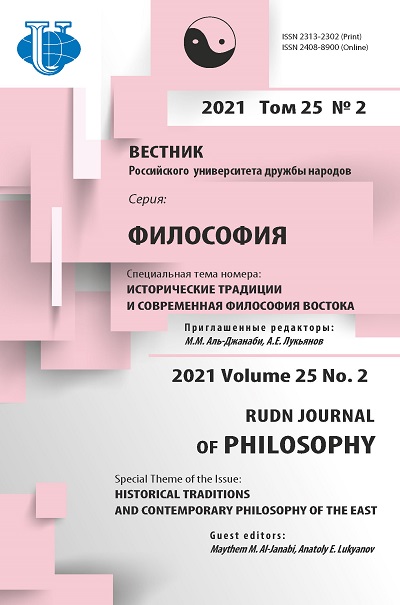Bodily Contemplation: On the Question of the Truth of the Perception of Physical Objects in Chinese Landscape Painting
- Authors: Wang Y.1
-
Affiliations:
- Sichuan University
- Issue: Vol 25, No 2 (2021): HISTORICAL TRADITIONS AND CONTEMPORARY PHILOSOPHY OF THE EAST
- Pages: 298-310
- Section: HISTORICAL TRADITIONS AND CONTEMPORARY PHILOSOPHY OF THE EAST
- URL: https://journals.rudn.ru/philosophy/article/view/26672
- DOI: https://doi.org/10.22363/2313-2302-2021-25-2-298-310
Cite item
Full Text
Abstract
This article analyzes the views of representatives of the scientific community on ancient Chinese landscape painting, emphasis is mainly placed on views that concern the spiritual qualities of landscape painting, as well as rethinking concepts that ignore the significance of sensual perception. Landscape painting is usually considered as a spiritual work of Taoism: landscape painting developed from Taoist thought, Taoist philosophy determined the identity of the artistic style and the inherent spirit of landscape painting. Moreover, some researchers even believe that bodily contemplation of landscape painting means setting the very original nature of mountains and waters, and the "knowledge of the truth" is a spiritual process that is more blocked by the human capacity for sensual perception. Some of the scientists completely deny the possibility and truth of sensual perception of physical objects in landscape painting. The author of this article believes that the spiritual component of landscape painting lurks precisely in the value of sensual perception, and bodily contemplation of mountains and waters is impossible without the participation of the body, clear confirmation of which we find in the ancient Chinese theory of arts. Ancient Chinese works of art traditionally had a close connection with sensual perception through bodily contemplation. This process is not simply about capturing object information, but when the subject takes an active part in the vision of the object, when the subject gives feedback to the object, and through acquiring the object its meaning is transmitted. Only through bodily contemplation, the individual can fully feel the artistic value of landscape painting, and Taoist philosophy thus gains a real existence in landscape painting, becoming a kind of emotional thinking.
About the authors
Yiqun Wang
Sichuan University
Author for correspondence.
Email: 770972623@qq.com
Ph. D. of Literature, Deputy Director of the Russian Studies Center, Research Associate, School of International Studies
17, People's South Road, Chengdu, 610041, People's Republic of ChinaReferences
- Xi Go. Linquan gaozhi. Nanjing: Jiangsu fenghuan wenyi chubanshe; 2015. (In Chinese).
- Fuguan Xu. Zhongguo yishu jingshen. Beijing: Shangwu yinshuguan; 2010. (In Chinese).
- Juhan Gao. Tushuo zhongguo huihuashi. Li Yu yi. Beijing: shenghuo dushu xinzhi sanlianshudian; 2014. (In Chinese).
- Suliwen Maike. Shanchuan youyuan: zhonguo shanshuihua yishu. Hong Zaixin yi. Shanghai: Shanghai shuhua chubanshe; 2015. (In Chinese).
- Zhulian. Daxiang wuxing: huo lun huihua zhi feiketi. Zhang Ying yi. Zhengzhou: Henandaxue chubanshe; 2017. (In Chinese).
- Ping Wan zhibian. Lixiang de jingjie: lishi zhenshi zhong de shanshuihua. Beijing: Zhongxin chubanshe; 2019. (In Chinese).
- Xianqian Wang, Wu zhuan Li, Xiaohuan Shen. Zhuanzi jijie. Beijing: Zhonghua shuju; 1999. (In Chinese).
- Bing Zong, Wei Wang. Hua shanshui xu. Chen Chuanxi yijie. Beijing: Renmin meishu chubanshe; 1985. (In Chinese).
- Hao Jing, Bomin Wang zhushi, Yizhi Deng jiaoyue. Bi ji fa. Beijing: Renmin meishu chubanshe; 1963. (In Chinese).
- Jiyin Zhou bianzhu. Zhonguo lidai hualun: duoyin libian zhishi yanjiu. Nanjing: Jiangsu meishu chubanshe; 2013. (In Chinese).
- Zehou Li. Mei de licheng: chatu ben. Guilin: Guanxi shifandaxue chubanshe; 2000. (In Chinese).
- Baihua Zong. Meixue manbu. Wuhan: Changjiang wenyi chubanshe; 2019. (In Chinese).
- Jianhua Yu zhushi. Xuanhe huapu. Beijing: Renmin meishu chubanshe; 2017. (In Chinese).
- Meiluo Pangdi Molisi. Zhijue xianxiangxue. Jiang Zhihui yi. Beijing: Shangwu yinshuguan; 2001. (In Chinese).
- Jiyin Zhou bianzhu. Zhongguo haulun jiyao. Nanjing: Jiangsu meishu chubanshe; 2005. (In Chinese).
- Yonghao Wang. Zhonguo wenxuepiping fanchou shiwijiang. Shanghai: Huadong shifandaxue chubanshe; 2010. (In Chinese).
















